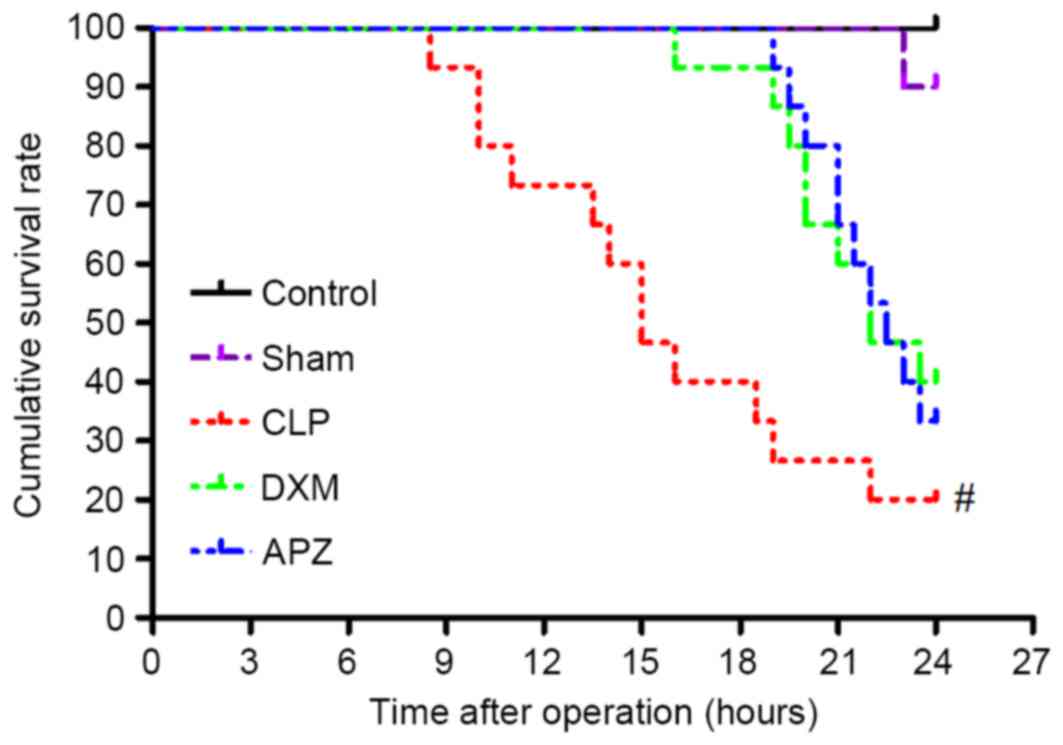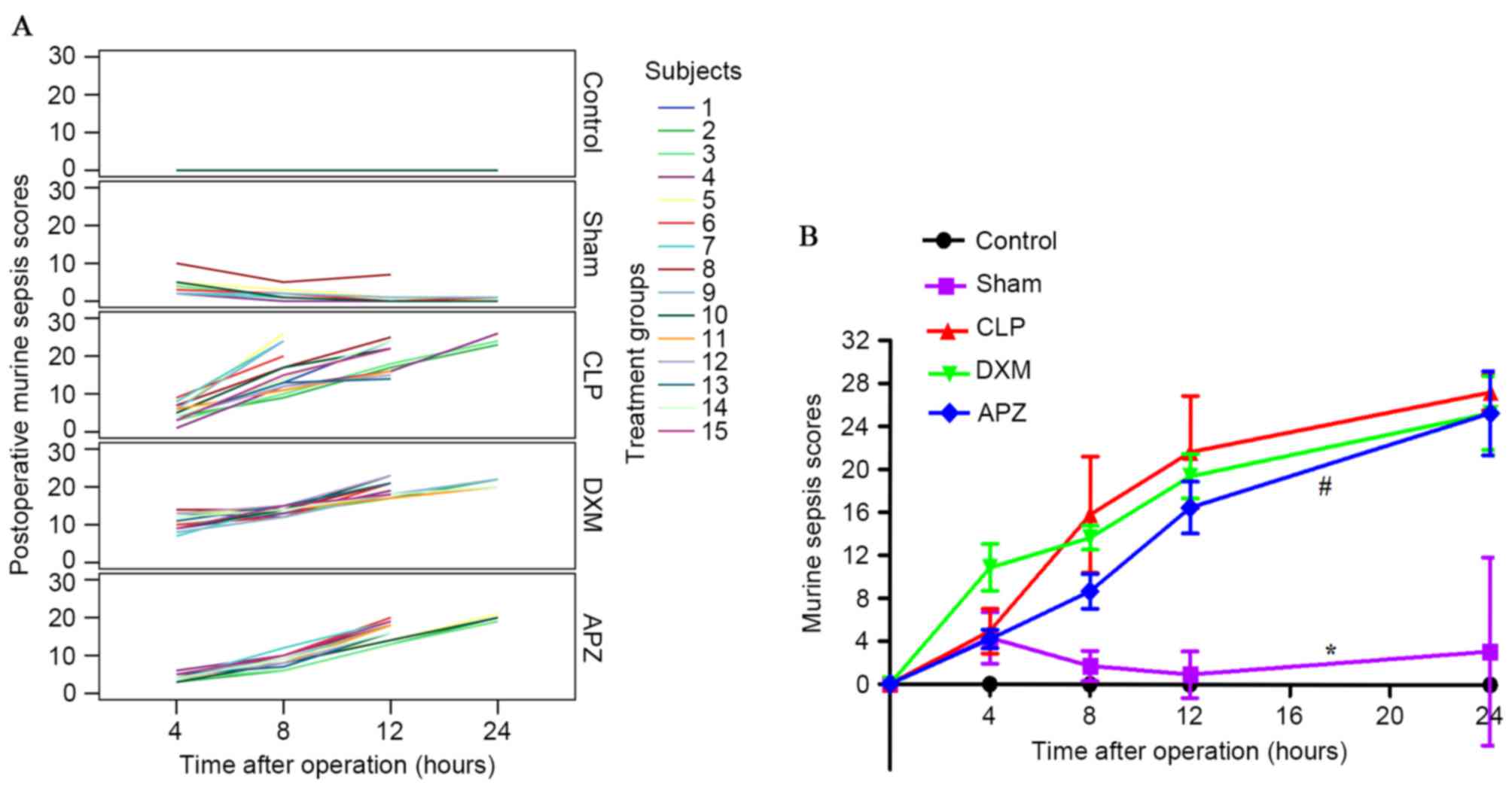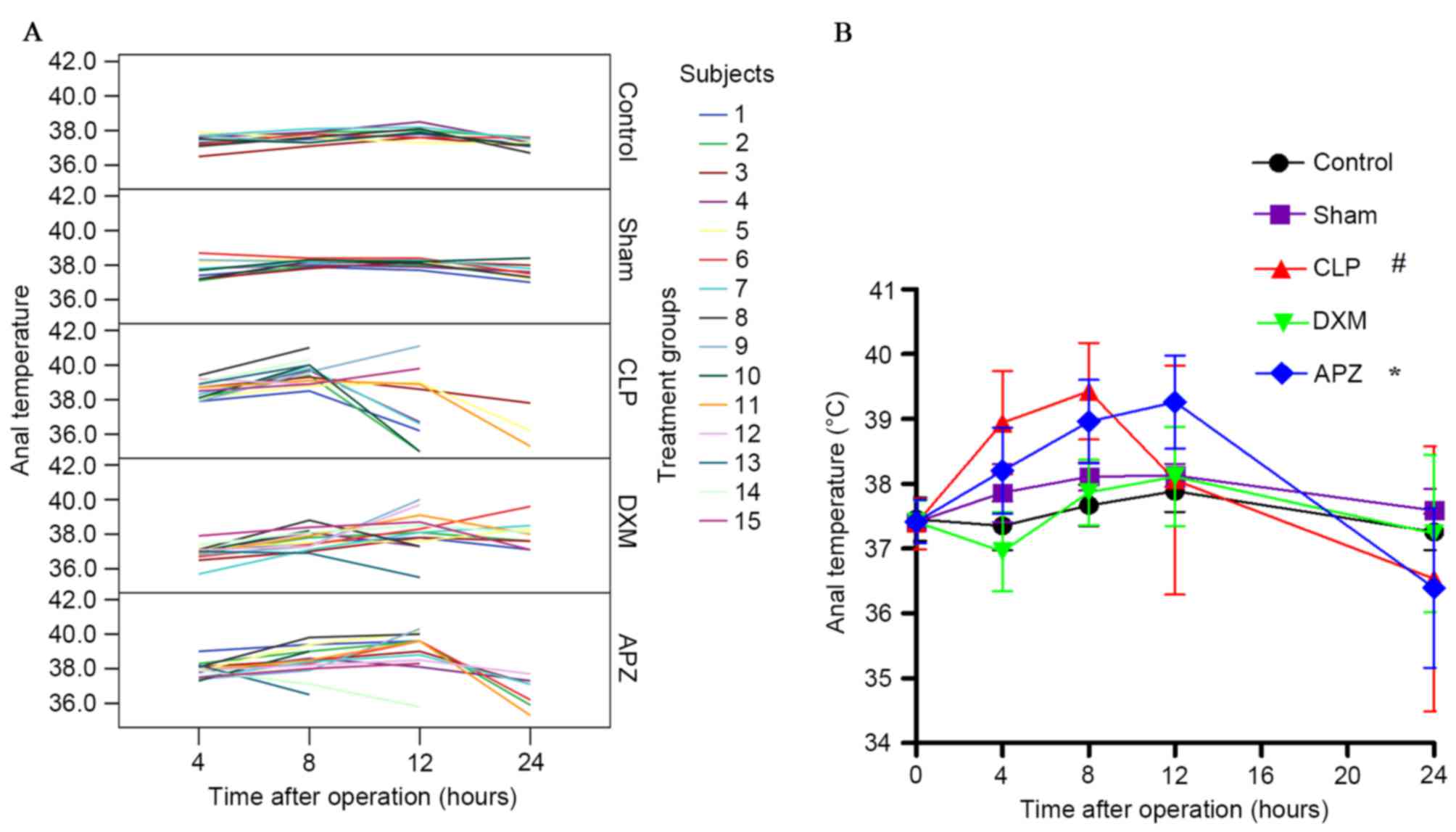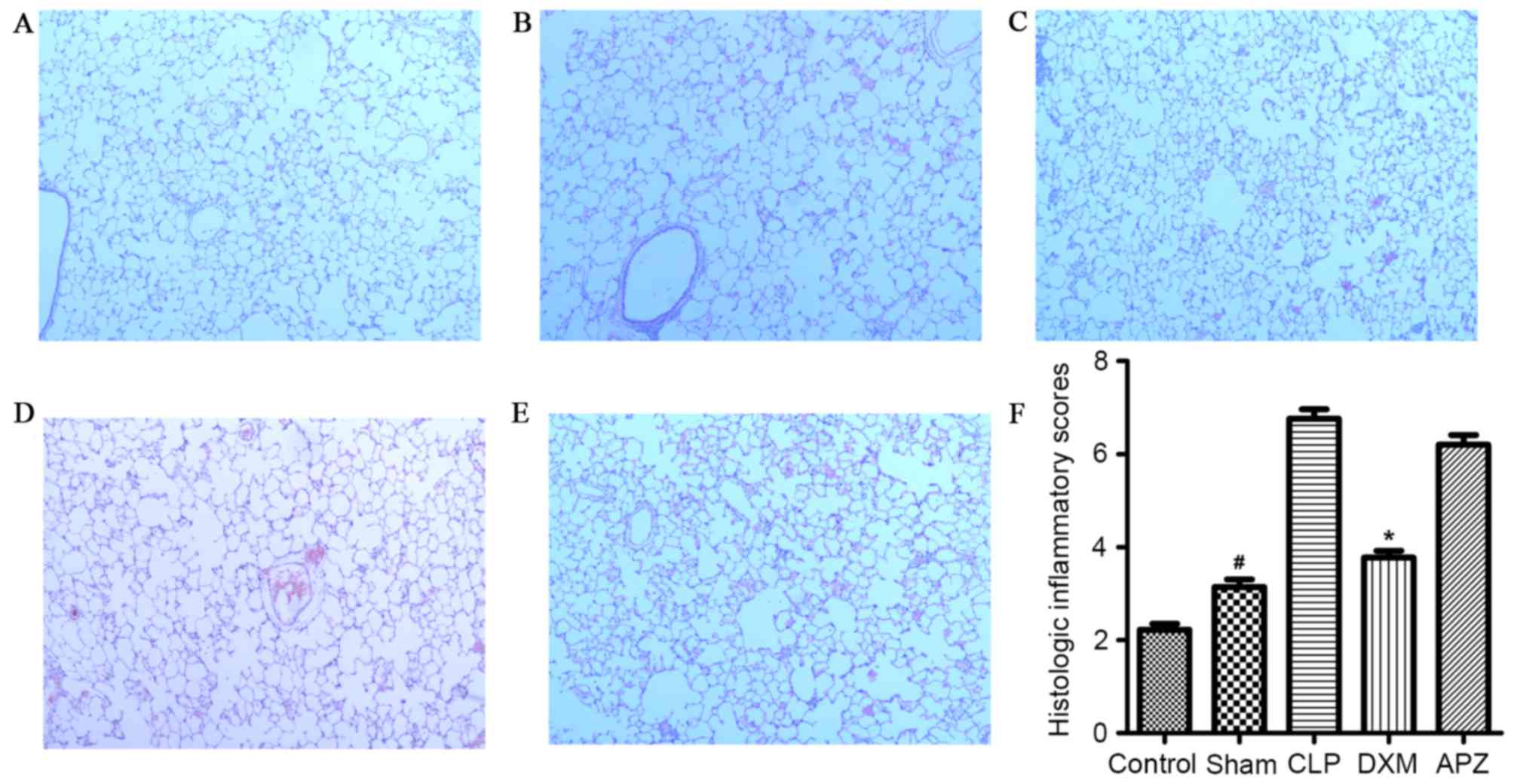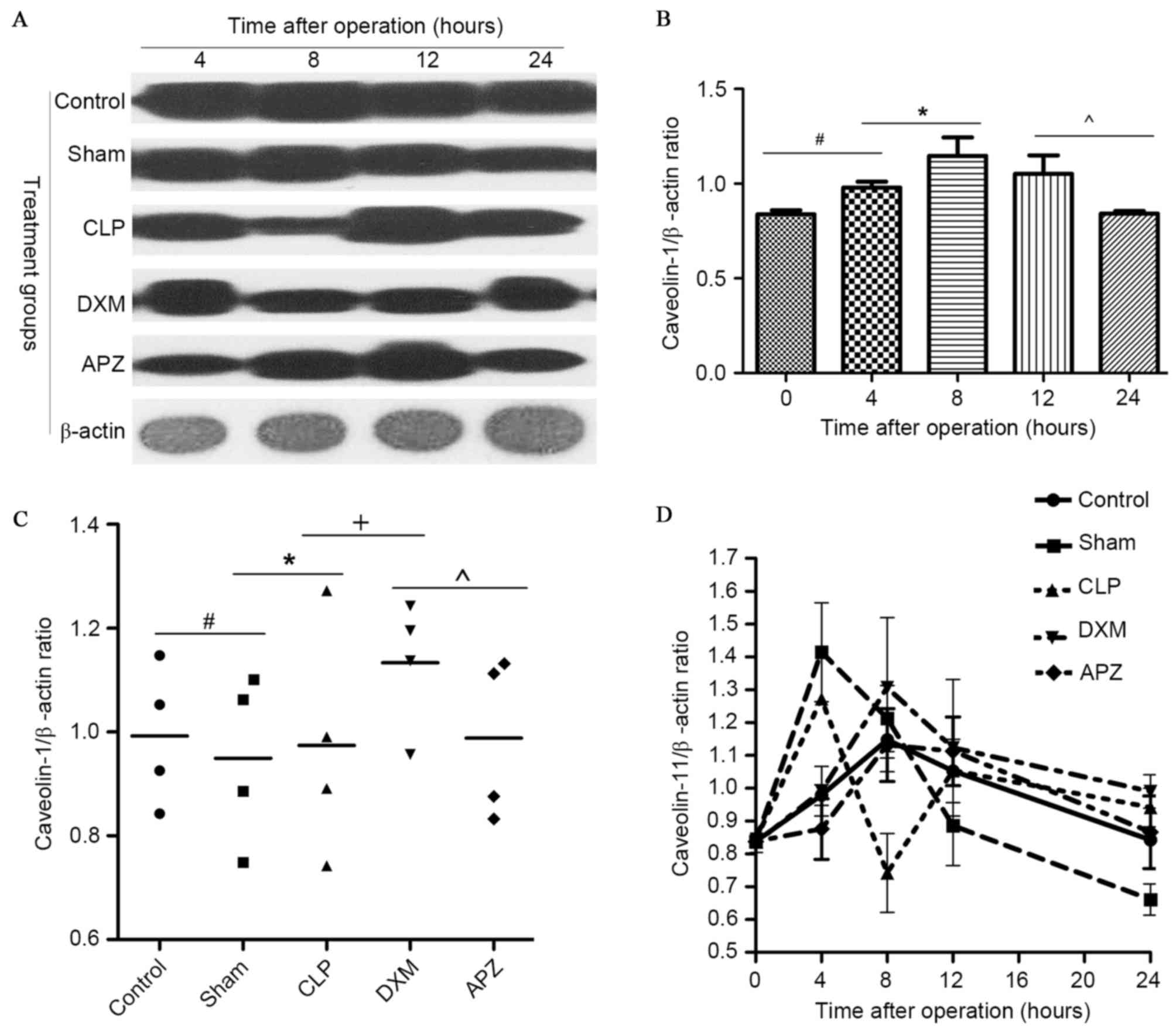|
1
|
Dellinger RP, Levy MM, Rhodes A, Annane D,
Gerlach H, Opal SM, Sevransky JE, Sprung CL, Douglas IS, Jaeschke
R, et al: Surviving sepsis campaign: International guidelines for
management of severe sepsis and septic shock, 2012. Intensive Care
Medicine. 39:165–228. 2013. View Article : Google Scholar : PubMed/NCBI
|
|
2
|
Xiao H, Siddiqui J and Remick DG:
Mechanisms of mortality in early and late sepsis. Infect Immun.
74:5227–5235. 2006. View Article : Google Scholar : PubMed/NCBI
|
|
3
|
Ernsberger P, Giuliano R, Willette RN and
Reis DJ: Role of imidazole receptors in the vasodepressor response
to clonidine analogs in the rostral ventrolateral medulla. J
Pharmacol Exp Ther. 253:408–418. 1990.PubMed/NCBI
|
|
4
|
Barr J, Fraser GL, Puntillo K, Ely EW,
Gélinas C, Dasta JF, Davidson JE, Devlin JW, Kress JP, Joffe AM, et
al: Clinical practice guidelines for the management of pain,
agitation, and delirium in adult patients in the intensive care
unit. Crit. Care Med. 41:263–306. 2013. View Article : Google Scholar : PubMed/NCBI
|
|
5
|
Pandharipande PP, Sanders RD, Girard TD,
McGrane S, Thompson JL, Shintani AK, Herr DL, Maze M and Ely EW:
MENDS investigators: Effect of dexmedetomidine versus lorazepam on
outcome in patients with sepsis: An apriori-designed analysis of
the MENDS randomized controlled trial. Crit Care. 14:R382010.
View Article : Google Scholar : PubMed/NCBI
|
|
6
|
Memiş D, Hekimoğlu S, Vatan I, Yandim T,
Yüksel M and Süt N: Effects of midazolam and dexmedetomidine on
inflammatory responses and gastric intramucosal pH to sepsis, in
critically ill patients. Br J Anaesth. 98:550–552. 2007. View Article : Google Scholar : PubMed/NCBI
|
|
7
|
Fraser GL, Devlin JW, Worby CP, Alhazzani
W, Barr J, Dasta JF, Kress JP, Davidson JE and Spencer FA:
Benzodiazepine versus nonbenzodiazepine-based sedation for
mechanically ventilated, critically ill adults: A systematic review
and meta-analysis of randomized trials. Crit Care Med. 41 Suppl
1:S30–S38. 2013. View Article : Google Scholar : PubMed/NCBI
|
|
8
|
Wu Y, Liu Y, Huang H, Zhu Y, Zhang Y, Lu F
and Zhou C, Huang L, Li X and Zhou C: Dexmedetomidine inhibits
inflammatory reaction in lung tissues of septic rats by suppressing
TLR4/NF-kB pathway. Mediators Inflamm. 2013.5621542013.PubMed/NCBI
|
|
9
|
Jiang L, Li L, Shen J, Qi Z and Guo L:
Effect of dexmedetomidine on lung ischemia-reperfusion injury. Mol
Med Rep. 9:419–426. 2014.PubMed/NCBI
|
|
10
|
Snapir A, Talke P, Posti J, Huiku M,
Kentala E and Scheinin M: Effects of nitric oxide synthase
inhibition on dexmedetomidine-induced vasoconstriction in healthy
human volunteers. Br J Anaesth. 102:38–46. 2009. View Article : Google Scholar : PubMed/NCBI
|
|
11
|
Si Y, Bao H, Han L, Shi H, Zhang Y, Xu L,
Liu C, Wang J, Yang X, Vohra A and Ma D: Dexmedetomidine protects
against renal ischemia and reperfusion injury by inhibiting the
JAK/STAT signaling activation. J Transl Med. 11:1412013. View Article : Google Scholar : PubMed/NCBI
|
|
12
|
Liu L, Brown D, McKee M, Lebrasseur NK,
Yang D, Albrecht KH, Ravid K and Pilch PF: Deletion of Cavin/PTRF
causes global loss of caveolae, dislipidemia, and glucose
intolerance. Cell Metab. 8:310–317. 2008. View Article : Google Scholar : PubMed/NCBI
|
|
13
|
Fu Y, Moore XL, Lee MK, Fernández-Rojo MA,
Parat MO, Parton RG, Meikle PJ, Sviridov D and Chin-Dusting JP:
Caveolin-1 plays a critical role in the differentiation of
monocytes into macrophages. Arterioscler Thromb Vasc Biol.
32:e117–e125. 2012. View Article : Google Scholar : PubMed/NCBI
|
|
14
|
Feng H, Guo L, Song Z, Gao H, Wang D, Fu
W, Han J, Li Z, Huang B and Li XA: Caveolin-1 protects against
sepsis by modulating inflammatory response, alleviating bacterial
burden, and supressing thymocyte apoptosis. J Biol Chem.
285:25154–25160. 2010. View Article : Google Scholar : PubMed/NCBI
|
|
15
|
Jiao H, Zhang Y, Yan Z, Wang ZG, Liu G,
Minshall RD, Malik AB and Hu G: Caveolin-1 Tyr14 phosphorylation
induces interaction with TLR4 in endothelial cells and mediates
MyD88-dependent signaling and sepsis-induced lung inflammation. J
Immunol. 191:6191–6199. 2013. View Article : Google Scholar : PubMed/NCBI
|
|
16
|
Calizo RC and Scarlata S: A role for
G-proteins in directing G-protein-coupled receptor-caveolae
localization. Biochemistry. 51:9513–9523. 2012. View Article : Google Scholar : PubMed/NCBI
|
|
17
|
D'Alessio A, Kluger MS, Li JH, Al-Lamki R,
Bradley JR and Pober JS: Targeting of tumor necrosis factor
receptor 1 to low density plasma membrane domains in human
endothelial cells. J Biol Chem. 285:23868–23879. 2010. View Article : Google Scholar : PubMed/NCBI
|
|
18
|
Chen Z, Bakhshi FR, Shajahan AN, Sharma T,
Mao M, Trane A, Bernatchez P, van Nieuw Amerongen GP, Bonini MG,
Skidgel RA, et al: Nitric oxide-dependent Src activation and
resultant caveolin-1 phosphorylation promote eNOS/caveolin-1
binding and eNOS inhibition. Mol Biol Cell. 23:1388–1398. 2012.
View Article : Google Scholar : PubMed/NCBI
|
|
19
|
Vetterkind S, Poythress RH, Lin QQ and
Morgan KG: Hierarchical scaffolding of an ERK1/2 activation
pathway. Cell Commun Signal. 11:652013. View Article : Google Scholar : PubMed/NCBI
|
|
20
|
Banquet S, Delannoy E, Agouni A, Dessy C,
Lacomme S, Hubert F, Richard V, Muller B and Leblais V: Role of
Gi/o-Src kinase-PI3K/Akt pathway and caveolin-1 in β2-adrenoceptor
coupling to endothelial NO synthase in mouse pulmonary artery. Cell
Signal. 23:1136–1143. 2011. View Article : Google Scholar : PubMed/NCBI
|
|
21
|
Toscano MG, Ganea D and Gamero AM: cecal
ligation puncture procedure. J Vis Exp. 28602011.PubMed/NCBI
|
|
22
|
Shrum B, Anantha RV, Xu SX, Donnelly M,
Haeryfar SM, McCormick JK and Mele T: A robust scoring system to
evaluate sepsis severity in an animal model. BMC Res Notes.
7:2332014. View Article : Google Scholar : PubMed/NCBI
|
|
23
|
Virtanen R: Pharmacological profiles of
medetomidine and its antagonist, atipamezole. Acta Vet Scand Suppl.
85:29–37. 1989.PubMed/NCBI
|
|
24
|
Madden CJ, Tupone D, Cano G and Morrison
SF: α2 adrenergic receptor-mediated inhibition of thermogenesis. J
Neurosci. 33:2017–2028. 2013. View Article : Google Scholar : PubMed/NCBI
|
|
25
|
Takahashi T, Kawano T, Eguchi S, Chi H,
Iwata H and Yokoyama M: Effects of dexmedetomidine on insulin
secretion from rat pancreatic β cells. J Anesth. 29:396–402. 2015.
View Article : Google Scholar : PubMed/NCBI
|
|
26
|
Restitutti F, Raekallio M, Vainionpää M,
Kuusela E and Vainio O: Plasma glucose, insulin, free fatty acids,
lactate and cortisol concentrations in dexmedetomidine-sedated dogs
with or without MK467: A peripheral α-2adrenoceptor antagonist. Vet
J. 193:481–485. 2012. View Article : Google Scholar : PubMed/NCBI
|
|
27
|
Cussac D, Schaak S, Gales C, Flordellis C,
Denis C and Paris H: alpha(2B)-adrenergic receptors activate MAPK
and modulate proliferation of primary cultured proximal tubule
cells. Am J Physiol Renal Physiol. 282:F943–F952. 2002. View Article : Google Scholar : PubMed/NCBI
|
|
28
|
Miranda ML, Balarini MM and Bouskela E:
Dexmedetomidine attenuates the microcirculatory derangements evoked
by experimental sepsis. Anesthesiology. 122:619–630. 2015.
View Article : Google Scholar : PubMed/NCBI
|
|
29
|
Drewry AM, Fuller BM, Skrupky LP and
Hotchkiss RS: The presence of hypothermia within 24 hours of sepsis
diagnosis predicts persistent lymphopenia. Crit Care Med.
43:1165–1196. 2015. View Article : Google Scholar : PubMed/NCBI
|
|
30
|
Hu G, Malik AB and Minshall RD: Toll-like
receptor 4 mediates neutrophil sequestration and lung injury
induced by endotoxin and hyperinflation. Crit care med. 38:194–201.
2010. View Article : Google Scholar : PubMed/NCBI
|
|
31
|
Li S, Okamoto T, Chun M, Sargiacomo M,
Casanova JE, Hansen SH, Nishimoto I and Lisanti M: Evidence for a
regulated interaction between heterotrimeric G proteins and
caveolin. J Biol Chem. 270:15693–15701. 1995. View Article : Google Scholar : PubMed/NCBI
|
|
32
|
Li S, Couet J and Lisanti MP: Src tyrosine
kinases, Galpha subunits, and H-Ras share a common
membrane-anchored scaffolding protein, caveolin. Caveolin binding
negatively regulates the auto-activation of Src tyrosine kinases. J
Biol Chem. 271:29182–29190. 1996. View Article : Google Scholar : PubMed/NCBI
|
|
33
|
Shajahan AN, Tirupathi C and Minshall RD:
Gbetagamma activation of Src induces caveolae-mediated endocytosis
in endothelial cells. J Biol Chem. 279:48055–48062. 2004.
View Article : Google Scholar : PubMed/NCBI
|
|
34
|
Mirza MK, Yuan J, Gao XP, Garrean S,
Brovkovych V, Malik AB, Tiruppathi C and Zhao YY: Caveolin-1
deficiency dampens Toll-like receptor 4 signaling through eNOS
activation. Am J Pathol. 176:2344–2351. 2010. View Article : Google Scholar : PubMed/NCBI
|
|
35
|
Feng H, Guo L, Song Z, Gao H, Wang D, Fu
W, Han J, Li Z, Huang B and Li XA: caveolin-1 protects against
sepsis by modulating inflammatory response, alleviating bacterial
burden, and supressing thymocyte apoptosis. J Biol Chem.
285:25154–25160. 2010. View Article : Google Scholar : PubMed/NCBI
|



